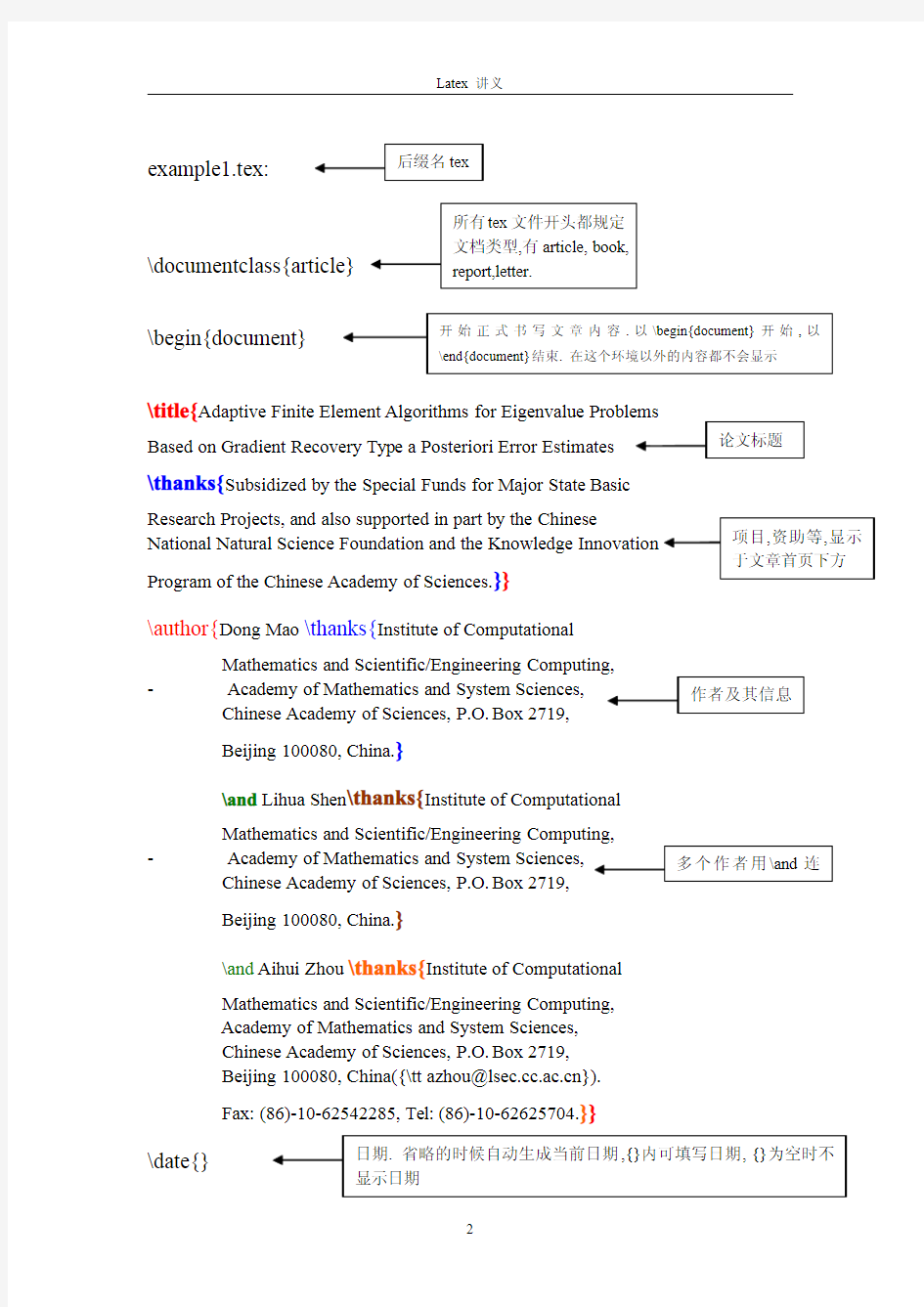我们简要讲述如何用Latex排版论文及书籍


Latex讲义
我们简要讲述如何用Latex排版论文及书籍.
相关资源:
https://www.360docs.net/doc/b517363917.html,
CTeX-2.4.2-Full CTeX-Fonts-2.4.4
CTeX-CS-1.4.3CTeX-Ext-1.1.0
参考书:
LaTeX科技排版指南作者:邓建松,彭冉冉,陈长松,科学出版社
https://www.360docs.net/doc/b517363917.html,/pub/tex/documents/bible/latex_manual.zip
CteX-FAQ:https://www.360docs.net/doc/b517363917.html,/pub/tex/CTDP/ctex-faq/
LaTeX插图指南(epslatex)中文版:
https://www.360docs.net/doc/b517363917.html,/pub/tex/documents/bible/latex_graphics.zip
C:\CTeX\CTEX\doc
1科技论文的结构
科技论文的结构一般主要包含如下几部分:
1.标题部份(包括论文题目,作者及其信息)
2.摘要
3.文章正文
4.参考文献
5.附录(大多文章没有)
与Word的一些比较:
1.用Latex排版时书写的是源文件(*.tex),需要编译以后才能得到需要的文件(一般为
*.pdf或*.ps);
2.在Word中,改变字体,颜色,插入空格,空行等,都通过菜单或工具栏直接在文件上
进行,而Latex是在源文件上,通过命令,环境来改变pdf或ps文件中的相应部份.
3.……
例一(eigen.pdf)
这几部分如何排版:例二(example1.tex)
example1.tex:\documentclass{article}
\begin{document}\title{Adaptive Finite Element Algorithms for Eigenvalue
Based on Gradient
Recovery Type a Posteriori Error Estimates \thanks{Subsidized by
the Special Funds for Major State Basic
Research Projects,and also supported in
part by the Chinese
National Natural Science Foundation and the Knowledge Innovation
Program of the Chinese Academy of Sciences.}}\author{Dong Mao \thanks{Institute of Computational
Mathematics and Scientific/Engineering -Academy of Mathematics and System Sciences,
Chinese Academy of Sciences,P.O.Box 2719,
Beijing 100080,China.}
\and Lihua Shen \thanks{Institute of Computational
Mathematics and Scientific/Engineering -Academy of Mathematics and System Sciences,
Chinese Academy of Sciences,P.O.Box 2719,
Beijing 100080,China.}
\and Aihui Zhou \thanks{Institute of Computational
Mathematics and Scientific/Engineering Computing,
Academy of Mathematics and System Sciences,
Chinese Academy of Sciences,P.O.Box 2719,
Beijing 100080,China({\tt azhou@https://www.360docs.net/doc/b517363917.html,}).
Fax:(86)-10-62542285,Tel:(86)-10-62625704.}}\date{}
\maketitle
\begin{abstract}The gradient recovery
element methods for problems since it provides efficient a posteriori error estimates by
a simple postprocessing.In this paper,the technique is introduced
to solve a class of symmetric and nonsymmetric eigenvalue problems.
Its efficiency and reliability is proven by both the theory and
numerical experiments on not only structured meshes but also
irregular meshes.
\end{abstract}
\section{Introduction}In lots of modern scientific as
computational material science and computational chemistry,the
eigenvalue computing has become more and more important.In the
context of eigenvalue computation,one of essential features is to
design adaptive algorithms.This work is devoted to propose and
analyze some adaptive finite element algorithms for a class
symmetric and nonsymmetric elliptic eigenvalue problems.For
simplicity,we consider a model problem:Find $(u,\lambda)\in
H_{0}^{1}(\Omega)\times R$such that
\begin{equation}\label{prob1}
\left\{\begin{array}{rcll}
Lu \equiv -\mbox{div}(A \nabla u)+\beta u &=&\lambda u,
&{\rm ~in~}\Omega,\\[1ex]
\|u \|_{0,\Omega}&=&1,
\end{array}\right.
\end{equation}
where $\Omega \subset R^{d}(d \geq 2)$is a polygonal domain with
the boundary $\partial \Omega$,$\beta \in L^{\infty}(\Omega)$is a
nonnegative real-value function,$A=(A_{ij}(x))_{d \times d}(1\leq
i,j \leq d)$is a given positive definite real-value function matrix
with that $A_{ij}(x)$is piecewise continuous on $\Omega$,namely,
there exist some subdomains $\{\Omega_1,\cdots,\Omega_M \}$such
that $\overline{\Omega}=\bigcup_{k=1,\cdots,M}
\overline{\Omega}_{k}$,$\Omega_{k_{1}}\cap \Omega_{k_{2}}=
\emptyset$when $k_{1}\neq k_{2}$,and $A_{ij}(x)\in W^{1,\infty}
(\Omega_{k})\cap H^2(\Omega_k)$.
Let $T^{h}=\{\tau \}$consist of shape-regular simplices $\Omega$with mesh-size
function $h(x)$whose value is the
diameter
$h_{\tau}$of the elements
$\tau$containing $x$.For any $G \subset
\Omega$,set
\[
h_{G}=\max_{x \in G}h(x),
\]
which is the (largest)mesh size of $\left.T^{h}\right|_{G}$.
\begin{thebibliography}{99}\bibitem{ad}{\sc R.~A.Adams},
{\em Sobolev Spaces},Academic Press,New York,1975.
\bibitem{ao1}{\sc M.~Ainsworth and J.~T.Oden},
{\em A posteriori error estimates in finite element analysis},
Comput.Methods Appl.Mech.Engrg.,142(1997),pp.~1-88.
\bibitem{ao2}{\sc M.~Ainsworth and J.~T.Oden},
{\em A Posterior Error Estimation in Finite Element Analysis},
Wiley,2000.
\end{thebibliography}
\end{document}注意:可以用\tableofcontents 生成目录。需要编译两次。
++
练习:参照example1.tex,写一篇你自己小论文,内容和篇幅不限,只要求结构正确.
注意:书写的时候可以把example1.tex中所有显示的实际内容删除,只剩下框架.在这个框架下填写你所需要书写的东西.
2基础知识
1.单词之间用一个或多个空格分开.多个空格和一个空格效果相同.
2.换行:生成的文件会自动换行,在tex文件中用一个回车换行只相当于一个空格符.两个回车(即一个空行)才能使生成的文件中相应文本换行.
3.如果要写英文论文,则用:\documentclass{article}
如果要写中文论文,则需要用:\documentclass{cctart}
注意:英文论文中不能包含中文字,而中文论文中可以包含英文.
练习:比较用article和cctart的区别
4.编号及其引用:
编号生成:每一章节,每个公式,图表,每个参考文献等,所有的编
号都会自动按先后顺序生成.
编号引用:不用管你所需要引用的编号是多少,只需要给它起个名字,在需要的地方引用这个名字即可,这个名字一般由英文字母,数字及-,_
组成.
(1)对于章节,公式等内容的起名及引用
起名\label{name}引用\ref{name}
(2)对于参考文献的起名及引用
名字放在\bibitem后面\bibitem{name}引用\cite{name}参考example1.tex
5.改变英文字体和字号
6.注释:用%来注释掉该行此后的内容。在Windows下,多行注释可选中目标,单击鼠标右键,选择Insert comment,取消注释选择Remove comment
3.居中和列表
1.文本居中
2.列表
4.公式环境最常见的公式环境包括如下几种:
一般在tex文件的\documentclass{…}下面用\usepackage{宏包名}
练习:1.写一个3x2的矩阵
2.练习上下标,分数,开方,求和等
3.练习多行公式的输入(特别是equation+arrray以及eqnarray)
4.练习公式编号的引用(\label{…}和\ref{…})
4图表和插图
表格:
Latex讲义
多个表格或插图放在一起
“Table”后面会跟一个数字,
即为表格的编号
用“minipage”把两个或多个
图标放在一起
规定这个图标占整个图标多宽,也可
以直接用长度,比如4cm
练习:1.用table 和
tabular 制作表格
2.尝试插入外部图形。
定义你自己的命令:“Table ”后面会跟一个数字,即为表格的编号
1
2
